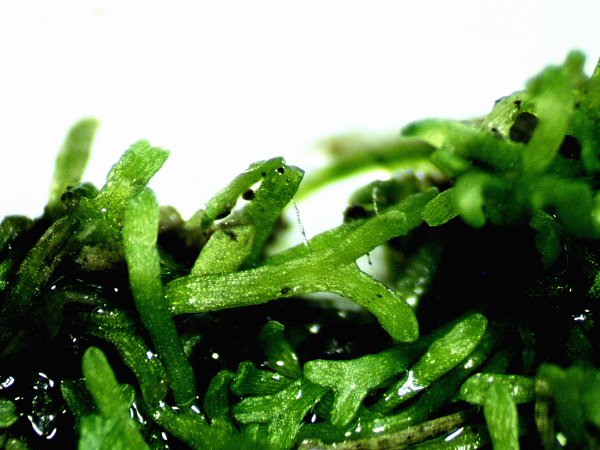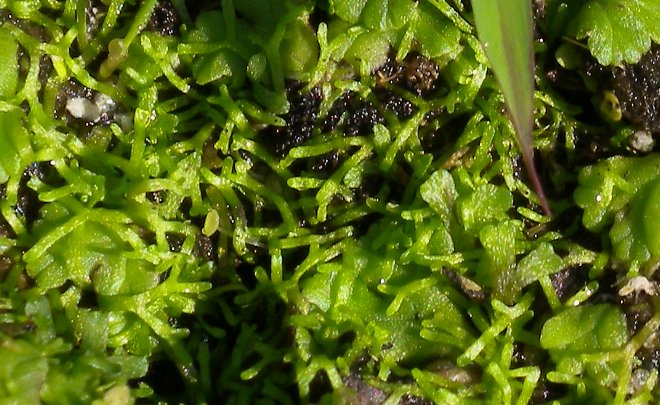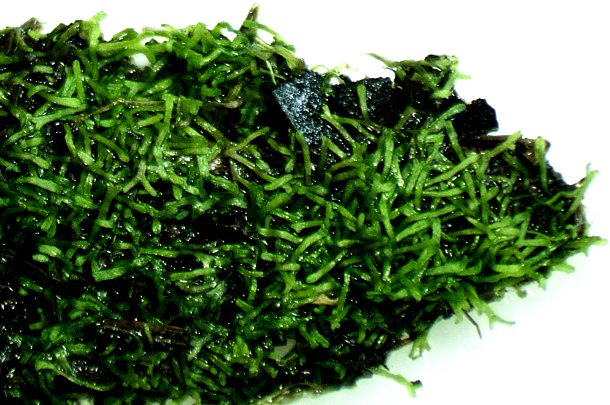Floating Crystalwort
Riccia fluitans
Crystalwort family (Ricciaceae)
Riccia fluitans
Crystalwort family (Ricciaceae)
Description:
This perennial liverwort consists of a thallus (a body of primitive
plant tissue that is not differentiated into stems and leaves). This
thallus dichotomously
branches, often forming a tangled mass of Y-shaped segments. The
thallus branches are
0.5–0.8 mm. wide, 0.2–2 cm. long, and about 3–6 times as wide as they
are deep. The branches of the thallus diverge from each other, forming
an angle
of 60–90 degrees. The semi-translucent thallus is light to medium green
and it lacks scales. On the upper surface of the thallus, there is a
fine pattern of lines and air pores that is visible upon close
inspection; this upper surface lacks a longitudinal
dorsal groove, except sometimes at the extreme tips of branches, which
are either notched or unnotched. When the branch tips lack notches,
they
are either truncate or rounded. The lower one-third to one-half of each
thallus interior consists primarily starch-containing cells, while the
upper
one-half to two-thirds of the thallus interior consists primarily of
air pores
and chlorophyll-containing cells. The air pores provide the thallus
with buoyancy in water. Sometimes the lower surface of the thallus
produces very fine rhizoids (root-like structures) that can anchor the
thallus on wet ground along shorelines.

There is an aquatic form of this liverwort and a terrestrial form; they are very similar in appearance. The aquatic form is able to float in water, usually below the surface. This form has thalli that are slightly more slender than the terrestrial form, and the tips of its thallus branches are less likely to be notched. This liverwort is probably monoecious, but it rarely reproduces sexually. If fertilization occurs, a thallus develops sporophytes in its upper interior, which appear as slight swellings. The spores are released when the body of the surrounding thallus deteriorates. According to Schuster (1953), such spores are 50–80 microns across and spheroid in shape with an areolate surface (appearing as a network of circles or blunt polygons). More commonly, this liverwort reproduces asexually. Asexual reproduction can occur by the fragmentation of branched thalli, or by forming small adventitious branches along the mid-lower surface of thalli that later become separated. Both fragments and adventitious branches of thalli are capable of forming separate, fully-developed thalli. Floating Crystalwort (Riccia fluitans) is a perennial because the new branch tips of its thalli are able to survive the temperate winter and regenerate themselves during the spring and summer. Sometimes in late summer and early autumn, this liverwort can form large colonies of plants that are either suspended in water or stranded on wet shorelines.

Cultivation: Full sun, partial sun, or bright indirect light are required for growth, which can be rapid under suitable conditions. This liverwort prefers to float in relatively clear water that is stagnant or very slow moving, although it can also survive on wet ground that doesn't dry out. The pH of the water should be in the 6.0–8.0 range. Very acidic water, such as occurs in sphagnum bogs, is not preferred. This liverwort is often cultivated in aquariums by hobbyists.
Range & Habitat: The native Floating Crystalwort (Riccia fluitans) occurs occasionally in scattered areas throughout Illinois (see Distribution Map). This liverwort is widely distributed in both North America and Eurasia. Habitats include the water and shorelines of ponds (including quiet areas of small lakes), water or wet ground in Pin Oak flatwoods, water or wet ground in Bald Cypress swamps, marshes, fens, limestone sinkholes, muddy places along large rivers, slow-moving spring water in tall vegetation, water or wet ground in prairie swales, wet sandstone depressions in rocky areas, and ditches along roadsides and railroads. Wetlands in sandy areas with clear water are more likely to have this plant than wetlands in muddy areas with turbid water. Floating Crystalwort occurs in both high quality wetlands and lower quality wetlands, but it prefers the former. Bur-reeds (Sparganium spp.) are indicator plants for the presence of this small liverwort.

Faunal Associations: Little information is available about floral-faunal relationships for this liverwort at the present time. Dense colonies of Floating Crystalwort (Riccia fluitans) in water provide shelter for minnows, aquatic insects, and other small aquatic organisms. Strands of this small liverwort can be carried from one wetland to another on the feathers of geese, ducks, and other waterfowl.
Photographic Location: A sandy marsh at Bonnie's Prairie Nature Preserve in Iroquois County, Illinois. The larger liverwort in the on-site photos is Fringed Heartwort (Ricciocarpos natans). The off-site photos were taken with a microscope indoors.

Comments: Floating Crystalwort (Riccia fluitans) is the most common Crystalwort species (Riccia) in Illinois. It sometimes occurs with another aquatic liverwort that is fairly common, Fringed Heartwort (Ricciocarpos natans), but it can be easily distinguished from this latter species by its smaller size and more slender thalli. Floating Crystalwort is also easy to distinguish from non-aquatic Crystalwort species because its branched thalli are linear in shape, while the branched thalli of the latter are wider and more tongue-shaped (lingulate). There is, however, a complex of species (e.g., Riccia rhenana, Riccia canaliculata) that are very similar in appearance to Floating Crystalwort, although the taxonomy of these similar species is somewhat unstable and they are less common in North America. Generally, the other species of this complex differ by having 1) slightly wider thallus branches that often exceed 0.8 mm., 2) more divergent thallus branches that form wider angles of 80–105 degrees, 3) thallus branches that are only 2–3 times as wide as they are deep, 4) tips of thallus branches that are more conspicuously notched, 5) inconspicuous grooves along the upper surface of thallus branches, and/or 6) less conspicuous air pores or patterns along the upper surface of thallus branches. Some species of this complex are also more likely to reproduce sexually than Floating Crystalwort, especially when they are stranded on wet ground. See Schuster (1953) for a discussion of these differences.

There is an aquatic form of this liverwort and a terrestrial form; they are very similar in appearance. The aquatic form is able to float in water, usually below the surface. This form has thalli that are slightly more slender than the terrestrial form, and the tips of its thallus branches are less likely to be notched. This liverwort is probably monoecious, but it rarely reproduces sexually. If fertilization occurs, a thallus develops sporophytes in its upper interior, which appear as slight swellings. The spores are released when the body of the surrounding thallus deteriorates. According to Schuster (1953), such spores are 50–80 microns across and spheroid in shape with an areolate surface (appearing as a network of circles or blunt polygons). More commonly, this liverwort reproduces asexually. Asexual reproduction can occur by the fragmentation of branched thalli, or by forming small adventitious branches along the mid-lower surface of thalli that later become separated. Both fragments and adventitious branches of thalli are capable of forming separate, fully-developed thalli. Floating Crystalwort (Riccia fluitans) is a perennial because the new branch tips of its thalli are able to survive the temperate winter and regenerate themselves during the spring and summer. Sometimes in late summer and early autumn, this liverwort can form large colonies of plants that are either suspended in water or stranded on wet shorelines.

Cultivation: Full sun, partial sun, or bright indirect light are required for growth, which can be rapid under suitable conditions. This liverwort prefers to float in relatively clear water that is stagnant or very slow moving, although it can also survive on wet ground that doesn't dry out. The pH of the water should be in the 6.0–8.0 range. Very acidic water, such as occurs in sphagnum bogs, is not preferred. This liverwort is often cultivated in aquariums by hobbyists.
Range & Habitat: The native Floating Crystalwort (Riccia fluitans) occurs occasionally in scattered areas throughout Illinois (see Distribution Map). This liverwort is widely distributed in both North America and Eurasia. Habitats include the water and shorelines of ponds (including quiet areas of small lakes), water or wet ground in Pin Oak flatwoods, water or wet ground in Bald Cypress swamps, marshes, fens, limestone sinkholes, muddy places along large rivers, slow-moving spring water in tall vegetation, water or wet ground in prairie swales, wet sandstone depressions in rocky areas, and ditches along roadsides and railroads. Wetlands in sandy areas with clear water are more likely to have this plant than wetlands in muddy areas with turbid water. Floating Crystalwort occurs in both high quality wetlands and lower quality wetlands, but it prefers the former. Bur-reeds (Sparganium spp.) are indicator plants for the presence of this small liverwort.

Faunal Associations: Little information is available about floral-faunal relationships for this liverwort at the present time. Dense colonies of Floating Crystalwort (Riccia fluitans) in water provide shelter for minnows, aquatic insects, and other small aquatic organisms. Strands of this small liverwort can be carried from one wetland to another on the feathers of geese, ducks, and other waterfowl.
Photographic Location: A sandy marsh at Bonnie's Prairie Nature Preserve in Iroquois County, Illinois. The larger liverwort in the on-site photos is Fringed Heartwort (Ricciocarpos natans). The off-site photos were taken with a microscope indoors.

Comments: Floating Crystalwort (Riccia fluitans) is the most common Crystalwort species (Riccia) in Illinois. It sometimes occurs with another aquatic liverwort that is fairly common, Fringed Heartwort (Ricciocarpos natans), but it can be easily distinguished from this latter species by its smaller size and more slender thalli. Floating Crystalwort is also easy to distinguish from non-aquatic Crystalwort species because its branched thalli are linear in shape, while the branched thalli of the latter are wider and more tongue-shaped (lingulate). There is, however, a complex of species (e.g., Riccia rhenana, Riccia canaliculata) that are very similar in appearance to Floating Crystalwort, although the taxonomy of these similar species is somewhat unstable and they are less common in North America. Generally, the other species of this complex differ by having 1) slightly wider thallus branches that often exceed 0.8 mm., 2) more divergent thallus branches that form wider angles of 80–105 degrees, 3) thallus branches that are only 2–3 times as wide as they are deep, 4) tips of thallus branches that are more conspicuously notched, 5) inconspicuous grooves along the upper surface of thallus branches, and/or 6) less conspicuous air pores or patterns along the upper surface of thallus branches. Some species of this complex are also more likely to reproduce sexually than Floating Crystalwort, especially when they are stranded on wet ground. See Schuster (1953) for a discussion of these differences.